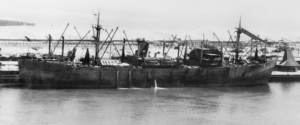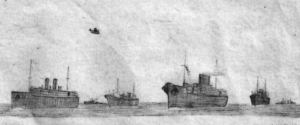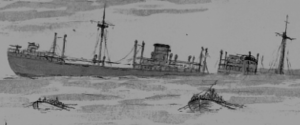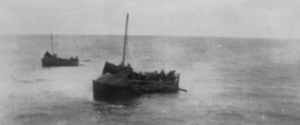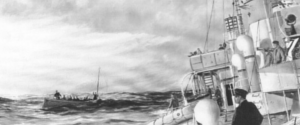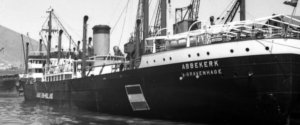800 miles south of Java: You can run but you can’t hide!

Men still speak of the miserable, sick fear that assailed them on that moonlight night. A blind hysteria pursued the ship. There was a feeling of utter disorganisation. Two men tried to kill themselves. To add to their troubles, the weather turned rough and cold. Sleeping on a bare deck with only a blanket, they were soaked and chilled to the bone.
‘They fought with what they had’ by Walter D. Edmonds
With their position now known to the enemy all they could do was wait for a formation of bombers or warships to appear or a torpedo from a submarine slamming into the ship. It was almost unbelievable that the by next morning nothing had happened. Maybe they were searched for in the wrong place since Abbekerk made a radical course change at dusk or they simply misjudged her speed. Maybe a submarine had fired torpedoes and missed. No one will ever know.
At sun up the following morning the bow of the ship was still slicing through the water at full speed. This and the knowledge that we had covered a good many miles gave us renewed hope. Of course there could be no certainty because S.O.S signals from ship close by were still coming in regularly.
Adriaan Kik, ass. engineer on Abbekerk
Life on board the crowded ship has slowly settled into a routine. With waiting in long queues for food and the latrines (and even salt water showers) taking up most of the time.
Fine weather, strong headwinds, a mildly rough sea. We lined up twice daily for chow: 0830 and 1530. Breakfast most often was scrambled (powdered eggs), beef hash and coffee. A typical dinner was beans, potatoes and hardtack. Drinking water was rationed to three times daily. There was little or no complaining, and no one had yet reported to sick bay. Not a single case of seasickness even. No planes or ships sighted all day. Towards evening, the sea became very rough with huge land swells.
Corporal Bill Heath, HQ Far East Air ForceSmoking on the deck was forbidden after sunset. The accumulated rubbish of the day was thrown overboard only at night time, so as not to give away our course to enemy planes or subs that might be searching for us. As I lay on the cold hard deck that night I had a chance to survey the entire ship. Looking towards the stern there were about five hundred Australians lying on top of the deck. There was no other place to go. The whole ship was full of various articles and we were told that fifty-caliber ammunition and bombs constituted some of our cargo. Looking forward I could see one open hold where the space had been converted so that it could be occupied by the Dutch and Javanese refugees.
Flight surgeon Captain James E. Crane, Far East Air Force

Oscar M Rudie (21), wounded on USS MArblehead was evacuated on Abbekerk (Source: USS Marblehead website)
There were several wounded men on board,some very seriously injured. Pilots as well as sailors from US warships. The few cabins on board were designated to the badly wounded and also some of the crew gave up their quarters.
Some of the wounded US navy men were from USS Houston and USS Marblehead, casualties from earlier battles against the Japanese. I went to visit them and one of the injured sailors was not happy with his lifejacket. His was an old one with hard blocks of cork knitted inside of it as floating device. Danger was that if you had to jump in the water from a height and failed to have your hands on top of the cork firmly, you could break your neck. I felt sorry for him, he had bad burns, so I exchanged my flock lifejacket with him.
At the time we were underway I gave sandwiches to those who asked. I was offered but took no money.
Bernard Finn, 17 y/o messboy on Abbekerk

The crew of the Shell Tanker Augustina were machinegunned in the lifeboats after they scuttled their own ship. There was 1 survivor.
(Picture: http://www.helderline.nl)
Losses (merchant ships only): 1 maart Augustina (Dutch): The tanker was scuttled to prevent capture by Harukaze ( Imperial Japanese Navy). Harukaze machine gunned the survivors in their lifeboats killing 39. Le Maire (Dutch): The cargo ship was torpedoed and sunk in the Indian Ocean by submarine I-2. No survivors. Modjokerto (Dutch): The cargo ship was sunk by Chikuma ( Imperial Japanese Navy) south of Christmas Island in the Indian Ocean. Forty-two crewmen killed and 25 survivors later executed in a P.O.W. camp. Parigi (Dutch): The cargo ship was sunk by submarine I-2 ( Imperial Japanese Navy). 18 survivors rescued by dutch submarine K XI and 8 by HMAS Yarra. 9 killed. USS Pecos (US): The tanker was bombed and sunk in the Indian Ocean off Christmas Island by Aichi D3A aircraft from aircraft carrier SÅryÅ«. Pecos was carrying survivors from USS Langley. Over 90 of the crew were killed. There were 232 survivors. Rooseboom (Dutch): The cargo ship was torpedoed and sunk by submarine I-59 west of Sumatra in the Indian Ocean. About 500 passengers and crew killed. Two survivors were rescued by Palopo on March 11. Siaoe (Dutch): The cargo ship was sunk by IJN warships near Bojonegoro, Java. Tomohon (Dutch): The cargo ship was sunk by Arashi and Nowaki 230 miles south of Tjilatjap in the Indian Ocean. 29 killed. Toradja (Dutch): The passenger/cargo ship was sunk by Arashi and Nowaki 250 miles south of Tjilatjap in the Indian Ocean. 11 crewmen killed. Sigli (Dutch): damaged by planes and later boarded and taken by a Japanese Destroyer
Source:
- https://en.wikipedia.org/wiki/List_of_shipwrecks_in_February_1942
- "De Nederlandse Koopvaardij in de Tweede Wereldoorlog" by L.L. von Münching

